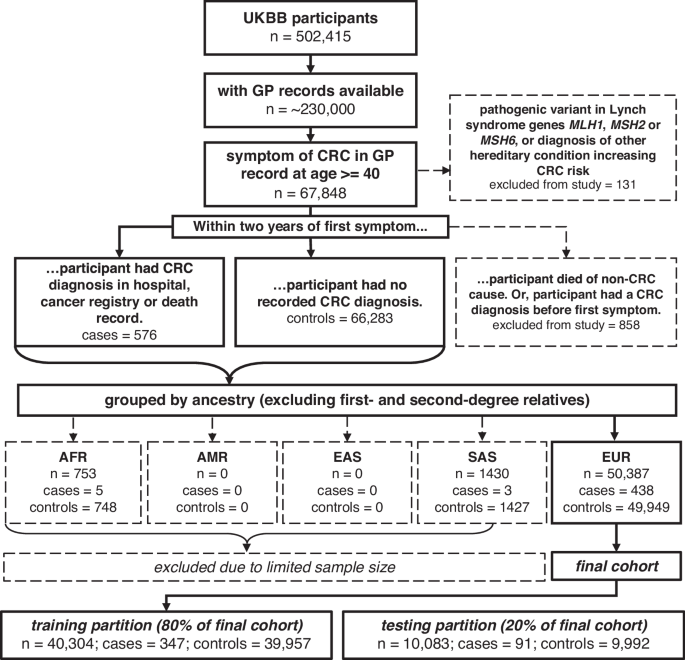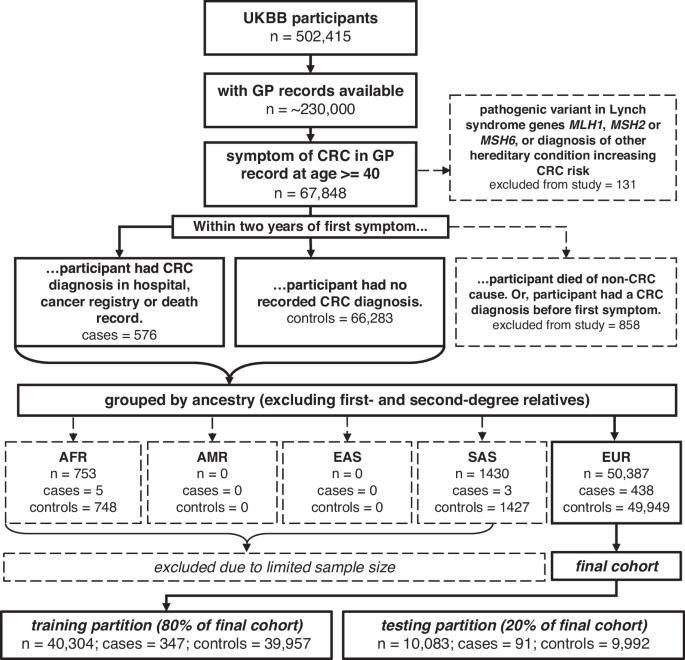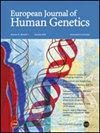使用多基因风险评分对有症状的初级保健患者进行结直肠癌风险分层--英国生物库回顾性队列研究。
IF 3.7
2区 生物学
Q2 BIOCHEMISTRY & MOLECULAR BIOLOGY
引用次数: 0
摘要
结直肠癌(CRC)是全球癌症死亡的主要原因。准确的癌症风险评估方法可以提高 CRC 的早期诊断率,改善患者的健康状况,减轻诊断服务的压力。针对便血的粪便免疫化学检验(FIT)被广泛用于初级保健,以识别可能患有 CRC 的无症状患者。然而,临床上对 FIT 的不符合率为 6-16%,超过 10 µg/g 检测阈值的无症状患者中约有 90% 没有患上 CRC。多基因风险评分(PRS)根据许多常见变异量化个人的遗传风险。迄今为止,现有的 CRC 风险评分系统都是用于对无症状人群进行分层。我们对 50,387 名 40 岁以上、初级保健记录中有 CRC 症状的英国生物库参与者进行了一项回顾性队列研究。利用逻辑回归评估了基于 201 个变异、5 个遗传主成分和 22 个其他 CRC 风险因素和标记物的 PRS 与首次出现症状后 2 年内 CRC 诊断的关联性。相关变量被纳入综合风险模型,并对 80% 的队列进行了训练,以预测 2 年内的 CRC 诊断。结合了 PRS、年龄、性别和患者报告症状的综合风险模型在测试队列中可预测 CRC 的发展(曲线下接收器操作特征面积,ROCAUC:0.76,95% 置信区间:0.71-0.81)。该模型有望改善对 CRC 的早期诊断,尤其是在患者不遵守 FIT 的情况下。本文章由计算机程序翻译,如有差异,请以英文原文为准。


Colorectal cancer risk stratification using a polygenic risk score in symptomatic primary care patients—a UK Biobank retrospective cohort study
Colorectal cancer (CRC) is a leading cause of cancer mortality worldwide. Accurate cancer risk assessment approaches could increase rates of early CRC diagnosis, improve health outcomes for patients and reduce pressure on diagnostic services. The faecal immunochemical test (FIT) for blood in stool is widely used in primary care to identify symptomatic patients with likely CRC. However, there is a 6–16% noncompliance rate with FIT in clinic and ~90% of patients over the symptomatic 10 µg/g test threshold do not have CRC. A polygenic risk score (PRS) quantifies an individual’s genetic risk of a condition based on many common variants. Existing PRS for CRC have so far been used to stratify asymptomatic populations. We conducted a retrospective cohort study of 50,387 UK Biobank participants with a CRC symptom in their primary care record at age 40+. A PRS based on 201 variants, 5 genetic principal components and 22 other risk factors and markers for CRC were assessed for association with CRC diagnosis within 2 years of first symptom presentation using logistic regression. Associated variables were included in an integrated risk model and trained in 80% of the cohort to predict CRC diagnosis within 2 years. An integrated risk model combining PRS, age, sex, and patient-reported symptoms was predictive of CRC development in a testing cohort (receiver operating characteristic area under the curve, ROCAUC: 0.76, 95% confidence interval: 0.71–0.81). This model has the potential to improve early diagnosis of CRC, particularly in cases of patient noncompliance with FIT.
求助全文
通过发布文献求助,成功后即可免费获取论文全文。
去求助
来源期刊

European Journal of Human Genetics
生物-生化与分子生物学
CiteScore
9.90
自引率
5.80%
发文量
216
审稿时长
2 months
期刊介绍:
The European Journal of Human Genetics is the official journal of the European Society of Human Genetics, publishing high-quality, original research papers, short reports and reviews in the rapidly expanding field of human genetics and genomics. It covers molecular, clinical and cytogenetics, interfacing between advanced biomedical research and the clinician, and bridging the great diversity of facilities, resources and viewpoints in the genetics community.
Key areas include:
-Monogenic and multifactorial disorders
-Development and malformation
-Hereditary cancer
-Medical Genomics
-Gene mapping and functional studies
-Genotype-phenotype correlations
-Genetic variation and genome diversity
-Statistical and computational genetics
-Bioinformatics
-Advances in diagnostics
-Therapy and prevention
-Animal models
-Genetic services
-Community genetics
 求助内容:
求助内容: 应助结果提醒方式:
应助结果提醒方式:


